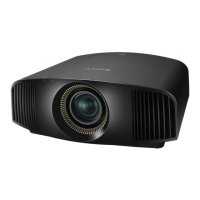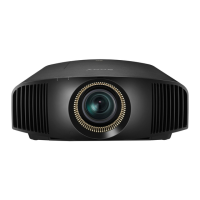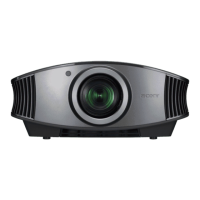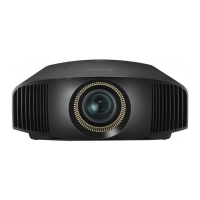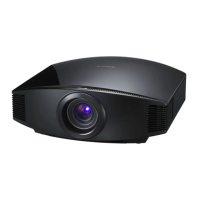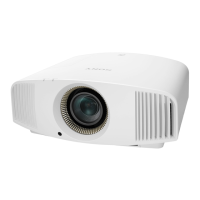Do you have a question about the Sony VPL-VW695ES and is the answer not in the manual?
Identifies buttons and connectors on the front and right side of the projector.
Details the control panel and ports on the rear, left, and bottom of the unit.
Explains the buttons and functions of the remote control.
Guide to physically positioning and setting up the projector for operation.
Steps for fine-tuning the projected image's position and focus.
Instructions for connecting video sources like computers and players via HDMI.
Procedures for turning the projector on, displaying images, and powering down.
Instructions on how to use and register the optional 3D glasses.
Details on adjusting 3D display settings and functions.
How to choose the correct aspect ratio for different video inputs.
Describes various preset modes like Cinema, TV, Photo, and Game for optimal viewing.
Explains how to navigate and interact with the projector's on-screen menus.
Details image quality adjustments like contrast, brightness, and color settings.
Covers aspect ratio, blanking, and screen display adjustments.
Configuration options for status, language, altitude, and power saving.
Adjustments for 3D features, dynamic range, and test patterns.
How to lock menu settings to prevent accidental changes.
Options for image flip, lens control, and trigger outputs.
Shows model name, serial number, software version, and lamp usage.
Accessing and controlling the projector via a web browser over the network.
Navigating and switching pages within the web-based control interface.
Configuring user access levels and passwords for network control.
Verifying current network settings and unit status through the interface.
Provides solutions for power, picture, and remote control problems.
Explains the meaning of ON/STANDBY and WARNING indicator lights.
Lists possible error messages and their corresponding causes and remedies.
Steps to download and install software updates for the projector.
Explains High Dynamic Range (HDR) and its benefits for picture quality.
Information on converting 2D content to 3D and its limitations.
Information regarding software licenses and product notices.
Step-by-step guide for safely replacing the projector lamp.
Instructions on how to clean the projector's exterior safely.
Lists key technical details like display system, resolution, and dimensions.
Details the supported video resolutions, refresh rates, and sync signals.
Shows which picture settings are adjustable based on the input signal type.
Lists the 3D resolutions and formats the projector accepts.
Indicates which picture settings are adjustable when using 3D signals.
Explains selectable aspect modes based on input signal or 3D format.
Details Motionflow settings like Smooth High, Smooth Low, and True Cinema.
Explains how picture settings are stored for each input and preset.
Information on determining the correct distance for desired screen size.
Explains the horizontal and vertical lens shift ranges.
Provides detailed measurements of the projector for installation planning.
Critical safety instructions for power, installation, and unit exposure.
Guidelines for safe handling and replacement of batteries.
Safety advice for using 3D glasses, including battery and handling.
General safety advice regarding operation, environment, and handling.
Instructions to ensure proper ventilation and prevent overheating.
Advice on saving and using original packaging for shipping.
Specific safety precautions for watching 3D content.
Explains normal visual characteristics of LCD projectors.
How to prevent and manage condensation inside the projector.
Recommendations for securing the projector's network connection.
Lists environments and positions that can cause projector malfunction or damage.
Prohibits specific actions during projector use, like tilting.
Safety measures and recommendations for mounting the projector on a ceiling.
Instructions for using the projector at high altitudes.
Identifies buttons and connectors on the front and right side of the projector.
Details the control panel and ports on the rear, left, and bottom of the unit.
Explains the buttons and functions of the remote control.
Guide to physically positioning and setting up the projector for operation.
Steps for fine-tuning the projected image's position and focus.
Instructions for connecting video sources like computers and players via HDMI.
Procedures for turning the projector on, displaying images, and powering down.
Instructions on how to use and register the optional 3D glasses.
Details on adjusting 3D display settings and functions.
How to choose the correct aspect ratio for different video inputs.
Describes various preset modes like Cinema, TV, Photo, and Game for optimal viewing.
Explains how to navigate and interact with the projector's on-screen menus.
Details image quality adjustments like contrast, brightness, and color settings.
Covers aspect ratio, blanking, and screen display adjustments.
Configuration options for status, language, altitude, and power saving.
Adjustments for 3D features, dynamic range, and test patterns.
How to lock menu settings to prevent accidental changes.
Options for image flip, lens control, and trigger outputs.
Shows model name, serial number, software version, and lamp usage.
Accessing and controlling the projector via a web browser over the network.
Navigating and switching pages within the web-based control interface.
Configuring user access levels and passwords for network control.
Verifying current network settings and unit status through the interface.
Provides solutions for power, picture, and remote control problems.
Explains the meaning of ON/STANDBY and WARNING indicator lights.
Lists possible error messages and their corresponding causes and remedies.
Steps to download and install software updates for the projector.
Explains High Dynamic Range (HDR) and its benefits for picture quality.
Information on converting 2D content to 3D and its limitations.
Information regarding software licenses and product notices.
Step-by-step guide for safely replacing the projector lamp.
Instructions on how to clean the projector's exterior safely.
Lists key technical details like display system, resolution, and dimensions.
Details the supported video resolutions, refresh rates, and sync signals.
Shows which picture settings are adjustable based on the input signal type.
Lists the 3D resolutions and formats the projector accepts.
Indicates which picture settings are adjustable when using 3D signals.
Explains selectable aspect modes based on input signal or 3D format.
Details Motionflow settings like Smooth High, Smooth Low, and True Cinema.
Explains how picture settings are stored for each input and preset.
Information on determining the correct distance for desired screen size.
Explains the horizontal and vertical lens shift ranges.
Provides detailed measurements of the projector for installation planning.
Critical safety instructions for power, installation, and unit exposure.
Guidelines for safe handling and replacement of batteries.
Safety advice for using 3D glasses, including battery and handling.
General safety advice regarding operation, environment, and handling.
Instructions to ensure proper ventilation and prevent overheating.
Advice on saving and using original packaging for shipping.
Specific safety precautions for watching 3D content.
Explains normal visual characteristics of LCD projectors.
How to prevent and manage condensation inside the projector.
Recommendations for securing the projector's network connection.
Lists environments and positions that can cause projector malfunction or damage.
Prohibits specific actions during projector use, like tilting.
Safety measures and recommendations for mounting the projector on a ceiling.
Instructions for using the projector at high altitudes.
| Light Source | Laser |
|---|---|
| Contrast Ratio | 350, 000:1 |
| Native Resolution | 4K (4096 x 2160) |
| HDMI Ports | 2 (HDCP 2.2) |
| Lamp Life | 20, 000 hours |
| Display System | SXRD |
| Brightness | 2, 000 lm |
| Lens Shift | Horizontal: ±31% |
| Screen Size | 60" to 300" |
| Color Space | DCI-P3 |
| Input/Output | USB, RS-232C, IR IN |
| Lamp Type | Laser |
| Input Lag | 27ms (4K 60p) |
| Inputs | HDMI, USB, RS-232C, IR IN |
| Throw Ratio | 1.38:1 to 2.83:1 |


